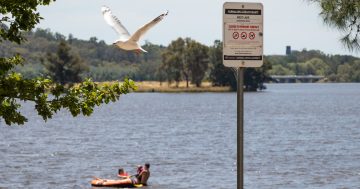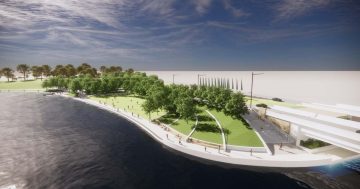
How much green space do we need in the bush capital?
Canberra is the bush capital in more than just name. Fingers of bush stretch deep into our suburbs. Ridgelines are protected so we can see the sky. Wilderness is nearby, streets are lined with huge trees. But as the city changes rapidly, will there still be room for green space?
Over the weekend Henry Rolland Park opened, in the midst of much dispute over West Basin’s future. As apartments mushroom around Civic and Braddon, the gloomy alleys of Haig Park are the only space to kick a footy or have a barbecue. Karen was minding her grandchildren there when I walked through last week. She lives nearby, she’s lukewarm about the park, but the kids chipped in fast: “There’s not enough room here to play properly! Where are the swings?”.

Haig Park is one the few green spaces for Braddon and Civic apartment dwellers
And that’s the heart of the problem: green space alone is not enough. It’s got to be useful, good quality, and it needs to match our growing population. National Trust president Eric Martin harks back to the Griffin Plan and Canberra’s garden city principles, pointing out that even the much-maligned Northbourne Flats were deliberately set within a wider landscape. Martin says integrating plenty of public green space is “a fundamental part of healthy living in the city”, and central to our identity and heritage.
That makes him sceptical about the City to the Lake plan if it means that waterfront real estate is prioritised over public access. And it’s not just about walkers and cyclists: he says apartments would also risk blocking out those glorious unfolding views of the Brindabellas from the Commonwealth Avenue Bridge.
“It’s a large lake with opportunities for recreation and some development, I don’t dispute that. But at the moment there are no heritage values or integrated plans for the whole lot. It’s piecemeal. It desperately needs a clearly defined strategy on how to handle the changes. The planning process is lagging behind our community concerns”.

Is the West Basin space ripe for development and re-design, or do we need to leave the lake alone?
Martin says that if spaces are high-quality people will use them, but not if they feel uneasy being there. That’s the problem with Haig Park, originally designed as a windbreak for the city, and currently undergoing a design re-think. But the bigger issue is that re-designing Haig Park won’t increase the amount of green space in the city. A pleasant park in West Basin won’t meet the needs of a potential boom in residents or ensure the rest of us can still enjoy the vistas.
So I think we also need to ask what kind of public access we all get. The Kingston lakeside, for example, is great if you’re ordering a seafood platter with a side of artisan sourdough, but not so welcoming if you’ve packed some sandwiches in the stroller for a family picnic. Contrast that with the people thronging Commonwealth Park, walking or running at Lake Ginninderra, or Lake Tuggeranong. They have room to move without feeling that you’re blocking the paying customers.
Anthony Burton has worked in the past with the government and now consults on environmental and community needs. He says we need to have a really good think about how we use green spaces. “We used to look at sports fields as recreation spaces”, he says, “but now planners understand that people see bush and parklands as important for their lifestyles, whether it’s walking the dogs, going for a run, doing bush care”.
“There is room for bush in the middle of the city but you wouldn’t look at that as a high-quality conservation space, because it’s just not big enough unless it links up. One echidna might need an overlapping range of up to 50ha, for example”. But he says education is important for conservation: “If you don’t know what’s in your backyard, you won’t protect it. So you do have to get people into the bush. You can’t lock it up”.
Burton says that other kinds of green space like community gardens can also be highly effective for building neighbourhoods. “People get advice, become friends, swap food. It’s as much about social gardening as vegetable gardening. These kinds of open spaces are higgeldy piggledy, they’re not necessarily beautiful to look at, but they are lovely places in terms of how people interact with each other”.
As we pack more people into our city and town centres, the land green spaces sit on also becomes increasingly valuable.
What green space does your suburb need and how do you use it?





















